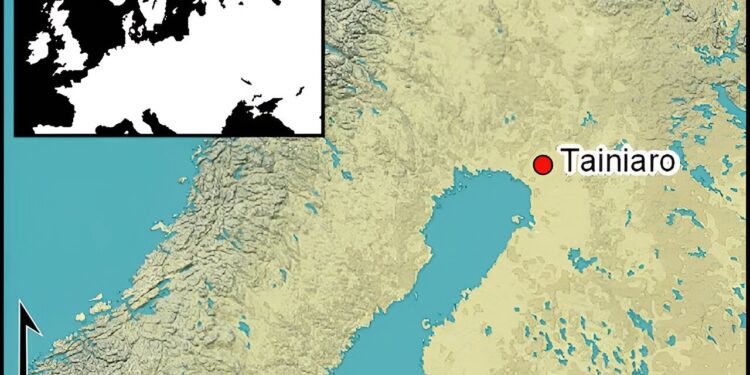Credit: antiquity (2023). DOI: 10.15184/aqy.2023.160
Just south of the Arctic Circle, in the vast forests of northern Finland, lies a sandy field dotted with dozens of “unusual” pits.
Workers stumbled upon the site, known as Tainiaro, sixty years ago, and since then its origins have remained elusive.
But now, after conducting a comprehensive analysis of the site, researchers have determined that it was likely a large hunter-gatherer cemetery dating back about 6,500 years, according to a study published Dec. 1 in the journal antiquity.
“Such a large cemetery located at such a high northern latitude does not necessarily fit preconceived ideas about prehistoric foragers in this region,” said researchers affiliated with Finland’s University of Oulu, adding that it may have been time to “recalibrate our expectations”.
During excavations conducted in 2018 and analysis of archival field work, researchers identified approximately 115 to 200 pits. Most were rectangular in shape and measured approximately 7 feet in length and 2.5 feet in depth.
No human remains were found inside, but thousands of objects, including pottery, ocher and burned animal bones, were discovered.
Skillfully crafted chisels and “hand-sized stones that could be made into tools with smaller blades” were also among the items found, Aki Hakonen, one of the study’s authors, told McClatchy News.
Comparing these pits to other Stone Age archaeological finds, researchers concluded that they were likely burial sites used by itinerant peoples who would have foraged, hunted and fished in the area.
“Tainiaro should, in our opinion, be considered a cemetery site,” the researchers said, “even though no skeletons have survived at Tainiaro.”
However, complicating their conclusion was evidence of burned material found inside some of the pits, suggesting they may have been hearths. However, the traces of charred material were insufficient to prove pyrotechnic use.
This discovery, however, indicates the possibility that the site was not only used to bury the dead.
“Indeed, it has recently been argued that Mesolithic places reserved for the dead were also places reserved for the living and that certain sites previously interpreted as cemeteries were in fact habitation sites with graves dug under the houses,” they said. indicated the researchers.
With this possibility in mind, the researchers said Tainiaro should not be considered a single-purpose site, but rather could have served multiple purposes.
If used, at least in part, as a burial site, it would be among the most important Stone Age cemeteries in Northern Europe.
Finland alone has more than 200 Stone Age burial sites, most of which are extremely small, Hakonen said.
“There are a few sites with around 20 burials, but even those are anomalies,” Hakonen said. “But more than 100 burials are confusing, and more than 200 is staggering.”
The Tainiaro site is particularly stunning because it is located in a harsh subarctic region with heavy snowfall in winter and temperatures that drop below 20 degrees Fahrenheit.
“It’s not a place where you would expect Stone Age gatherers to gather in large groups,” Hakonen said. “But maybe they did.”
More information:
Aki Hakonen et al, A large cemetery from the fifth millennium BC in the subarctic northern Baltic Sea?, antiquity (2023). DOI: 10.15184/aqy.2023.160
2023 The Charlotte Observer. Distributed by Tribune Content Agency, LLC.
Quote: ‘Unusual’ ancient tombs discovered near Arctic, but no remains discovered inside, study says (December 4, 2023) retrieved December 4, 2023 from
This document is subject to copyright. Except for fair use for private study or research purposes, no part may be reproduced without written permission. The content is provided for information only.



